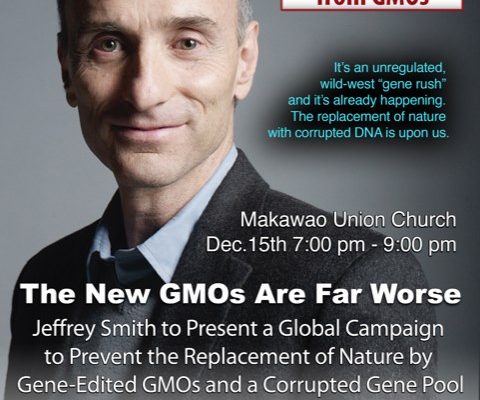Haleakala Times
May 06, 2008
by Rob Lafferty
“It does not mean that France does not participate in GMO research. It does not mean that there will not be GMOs in the future. It simply means that with the principle of precaution at stake, I am making a major political decision to carry our country to the forefront of the debate on the environment.” – French President Nicolas Sarkozy speaking in January about France’s ban of Monsanto 810 genetically modified corn.
In a world where every living thing is a food source for some other living thing, from the ultimate predator to the most primitive microbe, the quality of life for every species and plant genus is directly related to the quality of food available. We are what we eat.
Since the dawn of time humans have had WYSIWYG food – when you sat down to eat, What You Saw Is What You Got. If it looked and tasted like a potato, it was a potato. But you can’t be as sure as your ancestors were about what’s on your plate, because scientists are genetically modifying edible things in an ever-growing number of ways.
That’s not necessarily a bad thing, but our science has progressed faster than our ability to use it wisely. As a result of both greed and misguided zeal, Genetically Modified Organisms now make up a large percentage of the basic food crops that Earthlings eat. Like the proverbial careless farmer’s daughter, we’ve put a lot of our food into the same genetically modified basket.
And it’s not just humans who consume transgenic foods, or what some folks call “Frankenfoods” – the animals we eat are also being given GMOs in their feed along with a steady diet of antibiotic and hormone-laced food supplements.
Four patented products in particular serve as global examples of the problems and promises of GM crops – AstraZeneca’s “Golden” rice; Monsanto’s “MON 810 YieldGard Cornborer” corn and “NewLeaf” potato varieties; and BASF’s “Amflora” potato.
FrankenSpuds and Maize
Monsanto’s “NewLeaf Superior” potato, marketed by their subsidiary company NatureMark, was engineered to produce the insecticide Bacillus thuringiensis (Bt). Intended to kill nematodes and the Colorado potato beetle, the chemical was present in every cell of the plant. Because the strain also contained a patented “RoundUp Ready” gene that made it resistant to Monsanto’s specific formula of herbicide, NatureMark was required to register it with the Environmental Protection Agency as a pesticide, not a food. The Food and Drug Administration had no authority to regulate any NewLeaf potato varieties because the agency doesn’t regulate pesticides.
That’s all past tense; last fall NatureMark closed the facility that produced NewLeaf seed potatoes. They couldn’t get farmers to buy them because farmers couldn’t sell the finished crop. The old operation in Crystal, Maine is now being used to grow non-GM seed potatoes under a new company called SeedPro, formed by former NatureMark employees.
In 2006, GM potatoes accounted for almost five percent of the total U.S. potato production. In 2008 that number might be zero, as the market simply doesn’t exist in America to openly sell pesticide-laced, “RoundUp Ready” potatoes.
Last January France joined six other EU countries in suspending all cultivation of Monsanto’s patented YieldGard variety of corn, also marketed as Mon810 maize, anywhere within the country. The French responded to solid evidence that Bt in “Mon810” has a negative effect on insects, earthworms and microorganisms, and that its wind-born pollen can travel a hundred miles or more from the growing site and contaminate every organic or non-GMO cornfield along the way.
The “Amflora” potato developed by BASF is different from Monsanto’s NewLeaf brand. Instead of containing pesticides and being herbicide resistant, the Amflora has been modified to produce higher levels of starch. It’s also useless for human consumption – although it looks, feels and smells like an ordinary potato, it tastes terrible.
That’s not a problem for BASF because they plan to market the GMO for its amylopectin content, a starch useful in the food, paper, and chemical industries as paste, glue or as a lubricant. Normal potatoes contain two glucose polymers; amylopectin and amylose. According to company statements, BASF researchers have “switched off” the gene for amylose in Amflora potatoes to produce larger quantities of amylopectin, the more desirable starch for most applications.
The problem for consumers comes indirectly, as BASF also wants to market the potato residue after starch extraction for use in animal feed. That might not be a problem, except that the potato also contains antibiotic-resistant marker genes (ARMGs).
Public health agencies are concerned about the potential for ARMGs to be transferred from plants to bacteria, which would make those bacteria resistant to antibiotics. If Amflora residue is then fed to livestock, the GMOs it contains and the antibiotic resistance would enter the food chain on an even more widespread basis. That could destroy the effectiveness of antibiotics for treating specific infections in humans, which is already a growing health problem throughout the world.
The Amflora spud will probably gain approval to be grown in the European Union this spring with strict restrictions on open-field cultivation, but not all members will be required to allow it in their fields. A law that took effect in January makes farmers using GM plants legally responsible for the contamination of non-GMO crops and requires that all land used for GMO cultivation be listed in a public register.
From 1998 to 2004 the EU kept a moratorium against new GMOs in place while each country developed laws and policies regarding their use. As a result, only one percent of the GM crops grown on the planet are currently growing in Europe. The World Trade Organization and the United States (where 55 percent of the world’s acreage in GMO exists) have made progress in pressuring the EU to open its market following a 2006 WTO ruling that any ban on GMOs was an illegal trade barrier.
New, beautiful and fortified
In 2000, a merger involving several divisions of two companies, AstraZeneca and Norvartis, was completed to form a new Swiss-based company named Syngenta. That company then bought an exclusive license for the commercial use of Vitamin A-fortified “Golden” rice, a GM variety that looks lovely and produces provitamin A, more commonly known as beta-carotene. The intended use is meant mostly to address vitamin A deficiencies in the diets of poor and disadvantaged people in Third World countries.
Genes from daffodil flowers and from the bacterium Erwinia uredovora were inserted in the rice genome to produce the enzymes necessary to boost provitamin A levels by as much as 40 percent. Syngenta, which also makes a patented GA21 corn variety, plans to sell the seed cheaply to farmers in developing countries by charging more in the prosperous parts of the world. That almost sounds like a good thing, but there’s one glaring problem with using a transgenic approach to solving a dietary deficiency.
Since 1985, the International Food and Agricultural Organization has been fighting that same vitamin A deficiency by encouraging farmers and families to grow more leafy vegetables and add them to their primary diet of rice. The dietary problem has grown over the years in direct relationship to the number of farmers who accept government-funded incentives to grow high-yield “green revolution” rice varieties in a monoculture.
The subsequent loss of crop diversity was coupled with the fact that newer rice strains must be milled and polished in order to withstand the long periods of storage required for export. Unpolished, unmilled rice naturally contains vitamin A and iron; the modern process of polishing it for storage removes those nutrients. In the end, farmers and consumers are caught in a dependent cycle that is the exact opposite of the concept of sustainable living.
Proteins, amino acids and genetic mysteries
Lots of children in poor or overpopulated countries suffer from a lack of protein that hinders their physical growth, while a lack of lysine can slow their brain development. Modifying a plant for protein and amino acid enrichment is considered less risky than other forms of gene-tinkering because it usually involves splicing genes from other plant sources.
“If you’re going to use genetic modification at all, use it for this,” said Suman Sahai of India’s Gene Campaign, a consumer group that generally opposes GMOs and patented plants. “India’s problem is that we’re vegetarian, so tubers, pulses and legumes are the main protein source, but they’re in short supply and expensive.”
Plant geneticists at India’s national plant genome research center in Delhi are using a patented “AMA1” gene to create new varieties of potato, rice, cassava and yam. The gene is synthesized from the oddly named Amaranthus hypochondriacus plant that also serves as a food source.
According to Dr. Subhra Chakraborty of the New Dehli center, “These crops contain mostly carbohydrates and little protein at all. By adding the AMA1 gene we expect to render these foods more nutritious than they are at present.” Chakraborty said that the AMA1 gene boosted the protein content of potatoes by as much as 45 percent, raised the levels of two key amino acids and increased crop yields by 20 percent. It’s what she couldn’t say that raises troubling questions for consumers.
“We still do not know how exactly this gene does this,” said Chakraborty, who has been involved in this field of research for over 14 years.
Although it may be a good application of a high-risk, technology-based approach to increasing the quality and quantity of the food supply, it certainly isn’t the only answer. Adding even a small amount of peanut flour to ordinary wheat flour can enrich it with both protein and lysine. But peanut flour can’t be patented or licensed, so there’s little or no profit to be made unless you happen to be a peanut farmer.
At the point of pollination
The role of GMO technology in the rapid decline of commercial bee colonies in North America is just now coming under scrutiny. One possible factor are the crops grown from patented “Terminator” seeds developed by Monsanto, PioneerHiBred and other companies. Crops grown from such seeds are either sterile or will only geminate under specific conditions that usually include a patented fertilizer or insecticide as a necessary ingredient.
Genetic modification of a plant changes the flower pollen that plant produces. Bees collect that pollen and distribute it widely. If they didn’t, you’d probably be hungry right now, because there would be a lot fewer nuts, fruits, veggies and grains available – more than a third of North American food crops are pollinated by commercial beehives trucked around from place to place.
It’s those “domesticated” bees that are having health problems and abandoning hives. Wild bees, at least for now, are showing far lower rates of hive collapse. Other bees and insects aren’t raiding those deserted hives as they normally would, which has led bee researchers to the theory that a toxic overload is the cause of collapse. Many are concerned that the increased epidemic of the bee colony collapse has risen in conjunction with the increased emergence of GMOs in their food supply.
The end result
If there’s an upside to all the disturbing news about the future of food on Planet Earth, it may be that the emergence of GMO technology is providing an unexpected boost to backyard gardening and to the organic farming industry. It may not be possible to eliminate all Frankenfoods from the supply on grocery store shelves, but it is still possible to grow or buy a potato that looks, smells and tastes like the kind of potato your grandparents ate without getting some extra genetic material included.



